
94% of researchers rate our articles as excellent or good
Learn more about the work of our research integrity team to safeguard the quality of each article we publish.
Find out more
ORIGINAL RESEARCH article
Front. Astron. Space Sci. , 22 February 2022
Sec. Astrostatistics
Volume 9 - 2022 | https://doi.org/10.3389/fspas.2022.809771
This article is part of the Research Topic Asteroid Modeling: Processing and Combining Diverse Datasets View all 6 articles
The rotation period is one of the fundamental physical characteristics of asteroids. It can be determined from photometric measurements by standard methods of time-series period analysis or by creating a physical model of an asteroid with the rotation period being one of the fitted parameters. We used the latter approach to determine the sidereal rotation period for more than 5000 asteroids, out of which about 1600 are those for which their period was not known. We processed photometric measurements of about 100,000 asteroids from the ATLAS survey with the light curve inversion technique in the Asteroids@home project to search for the best-fit rotation period. This was repeated 25 times with randomly resampled—bootstrapped—data. For thousands of asteroids, their best-fit period was the same for most of the bootstrapped data sets; thus, their rotation period was determined with a high degree of reliability.
Asteroid photometry is a simple yet powerful tool to reveal some basic physical properties of observed objects. Time-resolved photometry—a light curve—provides a direct measurement of the rotation period. The vast majority of asteroid rotation periods (currently around 30,000 in the Asteroid Lightcurve Database, LCDB, of Warner et al., 2009)1 have been determined from light curve analysis.
When an asteroid is observed over a longer time interval (years), its light curves change as the aspect and the solar phase angle change. If the coverage of geometries is sufficient (which usually requires several apparitions for a main-belt asteroid), the evolving shape of the light curves uniquely defines the direction of the rotation axis and the convex shape of the asteroid, together with the sidereal rotation period (Kaasalainen and Ďurech, 2020). The process of reconstruction of asteroid shape and spin is called light curve inversion, and it can be done almost routinely if there is a sufficient amount of observations (Kaasalainen et al., 2001, 2002).
Apart from classical light curves that are true “curves” showing how the brightness evolves with time, there are also photometric observations that are sparse with respect to the rotation period. Thus, instead of a curve, we have individual sparse-in-time brightness measurements. This data type are typically produced by sky surveys and they can be used the same way as light curves for the shape and spin reconstruction of asteroids (Kaasalainen, 2004).
With the light curve inversion, the shape and spin of an asteroid are found by fitting a model (described by the rotation period P, the direction of the spin axis in ecliptic coordinates (λ, β), and parameters of a convex shape) to data. The best model is found by scanning the period/pole parameter space with the standard χ2 measure used to define the best agreement between the model and the data. Hundreds of models have been derived from dense photometry (Wang et al., 2015; Warner et al., 2017; Husárik, 2018; Marciniak et al., 2018; Franco and Pilcher, 2020, for example) and thousands from sparse photometry (Ďurech et al., 2009; Hanuš et al., 2013; Ďurech et al., 2016; Ďurech and Hanuš, 2018; Ďurech et al., 2020, for example). Sparse photometry is available from large sky-surveys (Pan-STARRS, ATLAS, Catalina, Gaia, ZTF, etc.) essentially for all asteroids. Because the photometric accuracy and the number of data points are usually not sufficient to derive a reliable model, the success rate of inversion of sparse data is low. However, as we show in this paper even when sparse data are not abundant enough to derive a reliable full spin/shape model, the rotation period can be derived uniquely.
This work aims to derive sidereal rotation periods of asteroids that have photometric data from the ATLAS survey. In our previous work (Ďurech et al., 2020), we used the same data to derive full shape/spin models.
In this work, we used the same data set as Ďurech et al. (2020). The data come from the Asteroid Terrestrial-impact Last Alert System (ATLAS) telescopes located in Hawaii (Tonry et al., 2018b,a; Smith et al., 2020; Heinze et al., 2018) and consist of photometric measurements collected from June 2015 to October 2018 in orange (o, 560–820 nm) and cyan (c, 420–650 nm) filters. The original data set consisted of photometry of about 180,000 asteroids. However, we selected only asteroids with at least 100 observations, which reduced the total number of objects to about 100,000.
We processed this data set at Asteroids@home project (Ďurech et al., 2015)—the best-fit sidereal rotation period was searched for at an interval of 2–1,000 h, and ten initial spin axis directions were tried for each trial period. The spin and shape parameters then converged to a local minimum in χ2. The global minimum in χ2 then defined the best-fit sidereal rotation period PA. This part of the work was, in fact, ready because we used the periodograms computed already by Ďurech et al. (2020). In our previous work (Ďurech et al., 2020), we selected the global minimum in χ2, tested its significance with respect to other global minima, checked the reliability of the shape model using the same processing pipeline as Ďurech et al. (2018), and reported the shape models with their rotation poles and periods. In our new approach, we concentrated only on rotation periods. We used a bootstrap (BS) method to resample the observations randomly and determine the period and its uncertainty via a Monte Carlo approach. We repeated the period scan for each BS realization, generated a new periodogram, and tested the robustness of the original best-fit period PA.
For each asteroid, we created 25 bootstrapped samples of the original data set in both filters independently (we randomly selected the same number of measurements) and repeated the period search, i.e., we computed other 25 periodograms at Asteroids@home. From each periodogram, we selected the best-fit period
The motivation for this approach was our expectation that if the best period is always the same for all BS samples, it is likely to be the actual rotation period. On the other hand, if the original period PA is not found in resampled BS data, it is likely just a random value not related to the real rotation period. Figure 1 shows the distribution of NBS, which is the number of cases when the best BS period
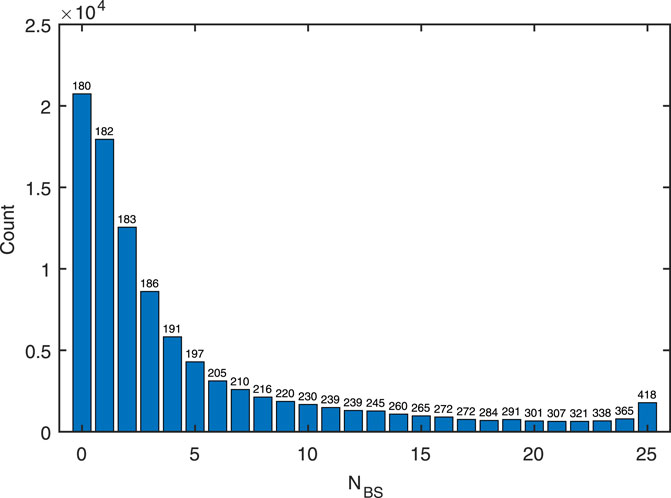
FIGURE 1. Histogram showing the number of asteroids with a given NBS—the number of cases in which the BS period was the same as the original one. The number above each histogram bar indicates the mean number of data points for asteroids in that sample.
If every BS sample gives the same best-fit period, then NBS = 25. If no
In Figure 2, we show a comparison between periods PA determined from the original ATLAS data and periods PDB taken from the LCDB of Warner et al. (2009) with the uncertainty tag U = 3 (release from June 2021, 3830 asteroids with U = 3). The uncertainty tag evaluates the reliability of the period and U = 3, the highest value, means that the period is unambiguous and uniquely determined. Asteroids with high NBS (red points, 20 ≤ ≤ NBS ≤ 25) lie primarily on the diagonal, which means that the periods PLCDB and PA are the same. For medium-reliability period determinations (blue points, 10 ≤ NBS ≤ 15), many PA values do not agree with the LCDB period, and often there is an alias of 24 or 48 h; or PA is half of PDB. For the low-reliability group (grey points, 1 ≤ NBS ≤ 6), there is no apparent relation between the two periods—PA periods are just arbitrary values not reliable at all.
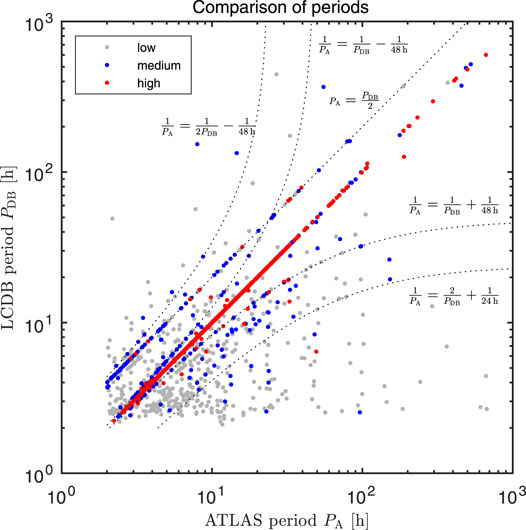
FIGURE 2. Comparison of periods PA derived from ATLAS data with the LCDB periods PDB for three different groups: low-reliability (1 ≤ NBS ≤ 6), medium-reliability (10 ≤ NBS ≤ 15), and high-reliability (10 ≤ NBS ≤ 25). The dotted curves indicate 24 or 48 h aliases and half-period alias that are common for less reliable periods.
Out of the total sample of ∼
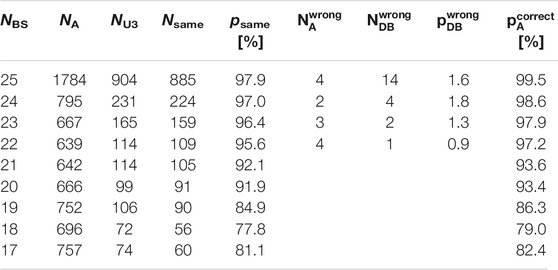
TABLE 1. For nine groups of asteroids with different NBS, the table lists the number NA of asteroids with a given NBS, the number NU3 of those that have U = 3 period record in the LCDB, the number Nsame of asteroids with the PA and PDB being the same (±5%), the probability psame = Nsame/NU3, the number of wrong ATLAS periods
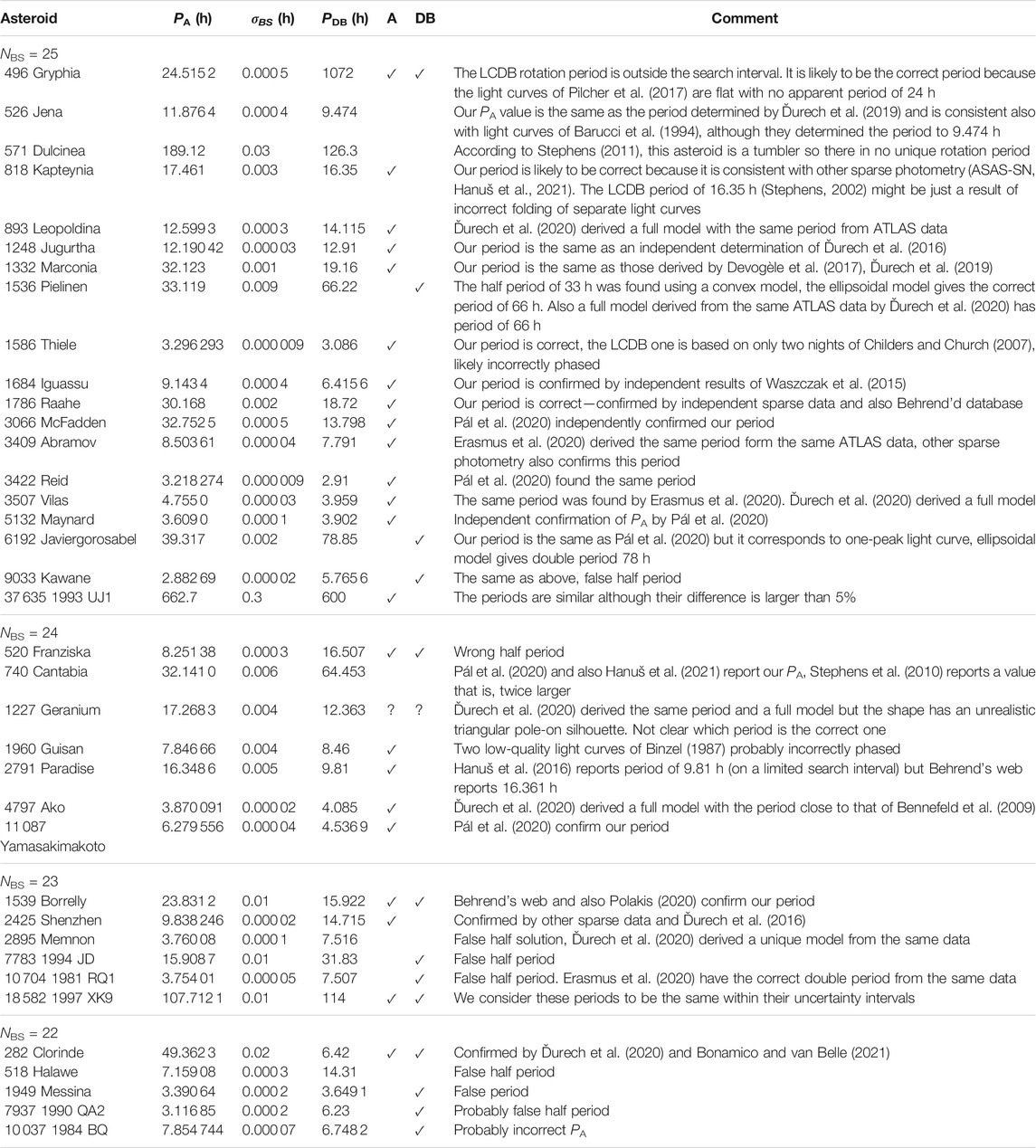
TABLE 2. List of asteroids with NBS ≥ 22 for which the period PA that we obtained from ATLAS data disagrees with the period PDB in the LCDB. The formal uncertainty of PA is σBS. By “✓,” we mark our decision if either ATLAS period (A) of LCDB period (DB) is correctly determined. Behrend’s web is a database of asteroid light curve observations and rotation periods available at https://obswww.unige.ch/behrend/page-cou.html.
We compared ATLAS and LCDB periods also for asteroids with NBS = 24, 23, 22 and inspected the discrepant cases (Table 2). The results are summarized in Table 1. The probability that for a given asteroid both periods are correct is a product of probabilities
The analysis above depends on the total number of BS samples, however, not critically. If, for some reason, we had only 22 BS samples in total, then for NBS = 22 (according to Table 1), NA = 3885, NU3 = 1414, Nsame = 1377, psame = 97.4%,
In total, the sample of asteroids with
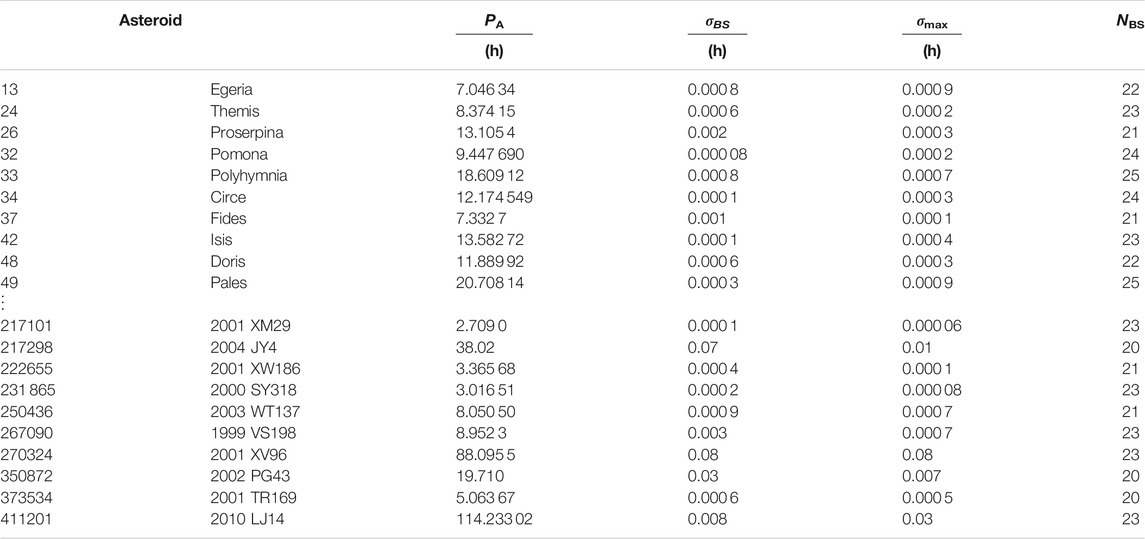
TABLE 3. For asteroids with NBS ≥ 20, the table lists their rotation period PA, the standard error σBS estimated from bootstrap, the uncertainty σmax of the period estimated from the length of the observing interval, and the number NBS of cases when PA was the same as
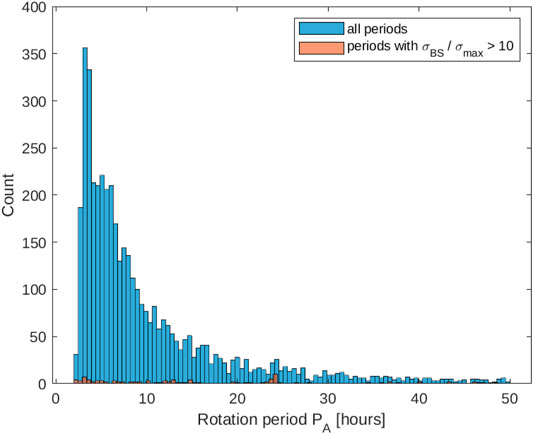
FIGURE 3. Distribution of periods derived from ATLAS data for NBS ≥ 20. The excess of periods around 24 h for asteroids with σBS/σmax > 10 is apparent.
For a part of asteroids with our ATLAS-based period determination, their rotation period was already known, sometimes also with a corresponding shape model. Namely, there are 3526 asteroids for which some period is reported in the LCDB; however, the number of reliable periods with U = 3 is only 1616. For 1600 asteroids, we derived their rotation period for the first time.
In Figure 4, we show a similar plot as Pál et al. (2020), namely the comparison of distribution of periods from the LCDB, TESS, and our ATLAS results. Although there is an apparent lack of long periods in our results when compared with TESS results of Pál et al. (2020), ATLAS sparse photometry can be used for an efficient determination of rotation periods of the order of hundreds of hours. Recent results of Erasmus et al. (2021) show that ground-based surveys are capable of detection rotation periods even longer than thousand hours. However, for the majority of asteroids in our sample, we were not able to determine their rotation period, so it is not possible to use the derived periods for statistical studies without properly accounting for bias.
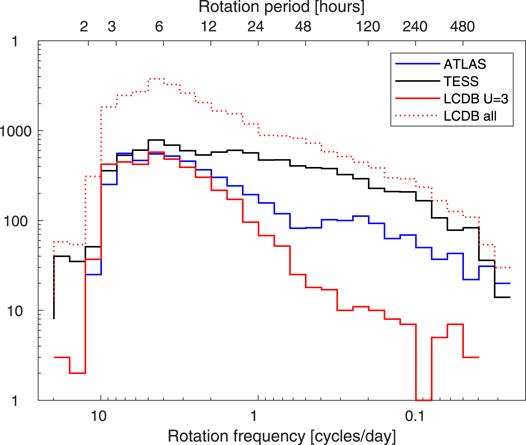
FIGURE 4. Comparison of distribution of periods from ATLAS (blue) with the LCDB periods for U = 3 (red), all LCDB periods (dotted red), and TESS data from Pál et al. (2020) (black).
We have derived sidereal rotation periods for more than 5000 asteroids; for more than 1600, it is the first period determination. The reliability of these periods is
The data analyzed in this study is subject to the following licenses/restrictions: ATLAS photometry. Requests to access these datasets should be directed to https://atlas.fallingstar.com.
JĎ—ATLAS data processing, bootstrap, interpretation; MV—processing of bootstrapped periodograms, interpretation; RV—technical administration of the Asteroids@home project; NE—ATLAS scientist.
This work has been supported by the grant 20-08218S of the Czech Science Foundation. This work has made use of data from the Asteroid Terrestrial-impact Last Alert System (ATLAS) project. ATLAS is primarily funded to search for near earth asteroids through NASA grants NN12AR55G, 80NSSC18K0284, and 80NSSC18K1575; byproducts of the NEO search include images and catalogs from the survey area. The ATLAS science products have been made possible through the contributions of the University of Hawaii Institute for Astronomy, the Queen’s University Belfast, the Space Telescope Science Institute, and the South African Astronomical Observatory (SAAO), and the Millennium Institute of Astrophysics (MAS), Chile.
The authors declare that the research was conducted in the absence of any commercial or financial relationships that could be construed as a potential conflict of interest.
All claims expressed in this article are solely those of the authors and do not necessarily represent those of their affiliated organizations, or those of the publisher, the editors and the reviewers. Any product that may be evaluated in this article, or claim that may be made by its manufacturer, is not guaranteed or endorsed by the publisher.
We greatly appreciate the contribution of tens of thousands of volunteers who joined the Asteroids@home BOINC project and provided their computing resources. This research has made use of IMCCE’s Miriade VO tool.
The Supplementary Material for this article can be found online at: https://www.frontiersin.org/articles/10.3389/fspas.2022.809771/full#supplementary-material
1https://minplanobs.org/MPInfo/
Barucci, M. A., di Martino, M., Dotto, E., Fulchignoni, M., Rotundi, A., and Burchi, R. (1994). Rotational Properties of Small Asteroids: Photoelectric Observations of 16 Asteroids. Icarus 109, 267–273. doi:10.1006/icar.1994.1092
Bennefeld, C., Bass, S., Blair, R., Cunningham, K., Hill, D., McHenry, M., et al. (2009). Asteroid Lightcurve Analysis at Ricky Observatory. Minor. Planet. Bull. 36, 147–148.
Binzel, R. P. (1987). A Photoelectric Survey of 130 Asteroids. Icarus 72, 135–208. doi:10.1016/0019-1035(87)90125-4
Bonamico, R., and van Belle, G. (2021). Determining the Rotational Period of Main-Belt Asteroid 282 Clorinde. Minor. Planet. Bull. 48, 210.
Childers, D., and Church, A. (2007). High-speed Photometric Analysis for Minor Planets 1586 Thiele, 4246 Telemann, (10662) 32-1 T-2, and (49880) 1999 XP 135. Minor. Planet. Bull. 34, 124–125.
Devogèle, M., Tanga, P., Bendjoya, P., Rivet, J. P., Surdej, J., Hanuš, J., et al. (2017). Shape and Spin Determination of Barbarian Asteroids. A&A 607, A119. doi:10.1051/0004-6361/201630104
Ďurech, J., Hanuš, J., and Alí-Lagoa, V. (2018). Asteroid Models Reconstructed from the Lowell Photometric Database and WISE Data. A&A 617, A57. doi:10.1051/0004-6361/201833437
Ďurech, J., Hanuš, J., Oszkiewicz, D., and Vančo, R. (2016). Asteroid Models from the Lowell Photometric Database. A&A 587, A48. doi:10.1051/0004-6361/201527573
Ďurech, J., and Hanuš, J. (2018). Reconstruction of Asteroid Spin States from Gaia DR2 Photometry. A&A 620, A91. doi:10.1051/0004-6361/201834007
Ďurech, J., Hanuš, J., and Vančo, R. (2015). Asteroids@home-A BOINC Distributed Computing Project for Asteroid Shape Reconstruction. Astron. Comput. 13, 80–84. doi:10.1016/j.ascom.2015.09.004
Ďurech, J., Hanuš, J., and Vančo, R. (2019). Inversion of Asteroid Photometry from Gaia DR2 and the Lowell Observatory Photometric Database. A&A 631, A2. doi:10.1051/0004-6361/201936341
Ďurech, J., Kaasalainen, M., Warner, B. D., Fauerbach, M., Marks, S. A., Fauvaud, S., et al. (2009). Asteroid Models from Combined Sparse and Dense Photometric Data. A&A 493, 291–297. doi:10.1051/0004-6361:200810393
Ďurech, J., Tonry, J., Erasmus, N., Denneau, L., Heinze, A. N., Flewelling, H., et al. (2020). Asteroid Models Reconstructed from ATLAS Photometry. A&A 643, A59. doi:10.1051/0004-6361/202037729
Erasmus, N., Kramer, D., McNeill, A., Trilling, D. E., Janse van Rensburg, P., van Belle, G. T., et al. (2021). Discovery of Superslow Rotating Asteroids with ATLAS and ZTF Photometry. MNRAS 506, 3872–3881. doi:10.1093/mnras/stab1888
Erasmus, N., Navarro-Meza, S., McNeill, A., Trilling, D. E., Sickafoose, A. A., Denneau, L., et al. (2020). Investigating Taxonomic Diversity within Asteroid Families through ATLAS Dual-Band Photometry. ApJS 247, 13. doi:10.3847/1538-4365/ab5e88
Franco, L., and Pilcher, F. (2020). Spin-Shape Model for 50 Virginia. Minor. Planet. Bull. 47, 272–274.
Hanuš, J., Ďurech, J., Brož, M., Marciniak, A., Warner, B. D., Pilcher, F., et al. (2013). Asteroids' Physical Models from Combined Dense and Sparse Photometry and Scaling of the YORP Effect by the Observed Obliquity Distribution. A&A 551, A67. doi:10.1051/0004-6361/201220701
Hanuš, J., Ďurech, J., Oszkiewicz, D. A., Behrend, R., Carry, B., Delbo, M., et al. (2016). New and Updated Convex Shape Models of Asteroids Based on Optical Data from a Large Collaboration Network. Astron. Astrophys. 586, A108. doi:10.1051/0004-6361/201527441
Hanuš, J., Pejcha, O., Shappee, B. J., Kochanek, C. S., Stanek, K. Z., and Holoien, T. W. S. (2021). V-band Photometry of Asteroids from ASAS-SN. Finding Asteroids with Slow Spin. Astron. Astrophys. 654, A48. doi:10.1051/0004-6361/202140759
Heinze, A. N., Tonry, J. L., Denneau, L., Flewelling, H., Stalder, B., Rest, A., et al. (2018). A First Catalog of Variable Stars Measured by the Asteroid Terrestrial-Impact Last Alert System (ATLAS). Aj 156, 241. doi:10.3847/1538-3881/aae47f
Husárik, M. (2018). Shape Model of the Asteroid (2501) Lohja from Long-Term Photometric Observations. Contrib. Astronomical Observatory Skalnate Pleso 48, 319–328.
Kaasalainen, M., and Ďurech, J. (2020). Asteroid Models from Generalised Projections: Essential Facts for Asteroid Modellers and Geometric Inverse Problem Solvers. arXiv e-prints , arXiv:2005.09947.
Kaasalainen, M., Mottola, S., and Fulchignoni, M. (2002). “Asteroid Models from Disk-Integrated Data,” in Asteroids III. Editors W. F. Bottke, A. Cellino, P. Paolicchi, and R. P. Binzel (Tucson: University of Arizona Press), 139–150. doi:10.2307/j.ctv1v7zdn4.17
Kaasalainen, M. (2004). Physical Models of Large Number of Asteroids from Calibrated Photometry Sparse in Time. A&A 422, L39–L42. doi:10.1051/0004-6361:20048003
Kaasalainen, M., Torppa, J., and Muinonen, K. (2001). Optimization Methods for Asteroid Lightcurve Inversion II. The Complete Inverse Problem. Icarus 153, 37–51. doi:10.1006/icar.2001.6674
Marciniak, A., Bartczak, P., Müller, T., Sanabria, J. J., Alí-Lagoa, V., Antonini, P., et al. (2018). Photometric Survey, Modelling, and Scaling of Long-Period and Low-Amplitude Asteroids. A&A 610, A7. doi:10.1051/0004-6361/201731479
Pál, A., Szakáts, R., Kiss, C., Bódi, A., Bognár, Z., Kalup, C., et al. (2020). Solar System Objects Observed with TESS-First Data Release: Bright Main-belt and Trojan Asteroids from the Southern Survey. ApJS 247, 26. doi:10.3847/1538-4365/ab64f0
Pilcher, F., Franco, L., and Pravec, P. (2017). 299 Thora and 496 Gryphia: Two More Very Slowly Rotating Asteroids. Minor. Planet. Bull. 44, 270–274.
Polakis, T. (2020). Photometric Observations of Thirty Minor Planets. Minor. Planet. Bull. 47, 177–186.
Smith, K. W., Smartt, S. J., Young, D. R., Tonry, J. L., Denneau, L., Flewelling, H., et al. (2020). Design and Operation of the ATLAS Transient Science Server. Pasp 132, 085002. doi:10.1088/1538-3873/ab936e
Stephens, R. D. (2011). Asteroids Observed From GMARS and Santana Observatories: 2010 October-December. Minor Planet Bulletin 38, 115.
Stephens, R. D. (2002). Photometry of 769 Tatjana, 818 Kapteyna, 1922 Zulu, and 3687 Dzus. Minor. Planet. Bull. 29, 72.
Stephens, R. D., Pilcher, F., Buchheim, R. K., Benishek, V., and Warner, B. D. (2010). Lightcurve Analysis of 740 Cantabia. Minor. Planet. Bull. 37, 17.
Tonry, J. L., Denneau, L., Flewelling, H., Heinze, A. N., Onken, C. A., Smartt, S. J., et al. (2018a). The ATLAS All-Sky Stellar Reference Catalog. ApJ 867, 105. doi:10.3847/1538-4357/aae386
Tonry, J. L., Denneau, L., Heinze, A. N., Stalder, B., Smith, K. W., Smartt, S. J., et al. (2018b). ATLAS: A High-Cadence All-Sky Survey System. Pasp 130, 064505. doi:10.1088/1538-3873/aabadf
Wang, X., Muinonen, K., Wang, Y., Behrend, R., Goncalves, R., Oey, J., et al. (2015). Photometric Analysis for the Spin and Shape Parameters of the C-type Main-belt Asteroids (171) Ophelia and (360) Carlova. A&A 581, A55. doi:10.1051/0004-6361/201526523
Warner, B. D., Pravec, P., Kusnirak, P., Benishek, V., and Ferrero, A. (2017). Preliminary Pole and Shape Models for Three Near-Earth Asteroids. Minor. Planet. Bull. 44, 203–212.
Warner, B. D., Harris, A. W., and Pravec, P. (2009). The Asteroid Lightcurve Database. Icarus 202, 134–146. doi:10.1016/j.icarus.2009.02.003
Keywords: asteroids, photometry, surveys, light curves, bootstrap
Citation: Ďurech J, Vávra M, Vančo R and Erasmus N (2022) Rotation Periods of Asteroids Determined With Bootstrap Convex Inversion From ATLAS Photometry. Front. Astron. Space Sci. 9:809771. doi: 10.3389/fspas.2022.809771
Received: 05 November 2021; Accepted: 17 January 2022;
Published: 22 February 2022.
Edited by:
Daniel Hestroffer, Université de Sciences Lettres de Paris, FranceReviewed by:
Alan Harris, NASA Jet Propulsion Laboratory (JPL), United StatesCopyright © 2022 Ďurech, Vávra, Vančo and Erasmus. This is an open-access article distributed under the terms of the Creative Commons Attribution License (CC BY). The use, distribution or reproduction in other forums is permitted, provided the original author(s) and the copyright owner(s) are credited and that the original publication in this journal is cited, in accordance with accepted academic practice. No use, distribution or reproduction is permitted which does not comply with these terms.
*Correspondence: Josef Ďurech, ZHVyZWNoQHNpcnJhaC50cm9qYS5tZmYuY3VuaS5jeg==
Disclaimer: All claims expressed in this article are solely those of the authors and do not necessarily represent those of their affiliated organizations, or those of the publisher, the editors and the reviewers. Any product that may be evaluated in this article or claim that may be made by its manufacturer is not guaranteed or endorsed by the publisher.
Research integrity at Frontiers

Learn more about the work of our research integrity team to safeguard the quality of each article we publish.